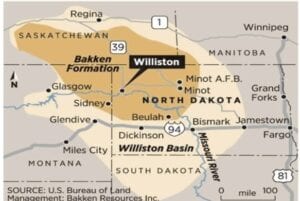oil that is not (a-) made from decaying biological organisms (-biotic), but from rhythmic cycles in the mantle of Earth. This theory (debunking the evolutionary fossil fuel theory) dates from the 19th Century when the French chemist Marcellin Berthelot and the Russian chemist Dmitri Mendeleev proposed to explain the origin of oil and their theories were revived in the decade after 1950 in Russia out of necessity. The science behind the theory is sound and is based on experimental evidence in both the lab and in the field. In its simplest form, the theory is that carbon present in the magma beneath the crust reacts with hydrogen to form methane as well as a raft of other mainly alkane hydrocarbons. Particular mineral rocks such as granite and other silicon based rocks act as catalysts, which speed up the reaction without actually becoming involved or consumed in the process.
“The capital fact to note is that petroleum was born in the depths of the Earth, and is only there that we must seek its origin” — Dmitri Mendeleev, 1877.
This theory has helped to identify and therefore develop large numbers of gas and oil deposits. Examples of such fields are the South Khylchuyu field and the controversial Sakhalin II field. Experiments have shown that under extreme conditions of heat and pressure it is possible to convert iron oxide, calcium carbonate and water into methane, with hydrocarbons containing up to 10 carbon atoms being produced by Russian scientists last century and confirmed in recent US experiments. The absence of large quantities of free gaseous oxygen in the magma prevents the hydrocarbons from burning and therefore forming the lower energy state molecule carbon dioxide. The conditions present in the Earth’s mantle would easily be sufficient for these small hydrocarbon chains to polymerise into the longer chain molecules found in crude oil.
The Nazi’s, who had been making synthetic oil out of coal, knew that oil is abiotic and not a fossil fuel that is biologically made from certain types of decaying matter. They developed what’s known as the Fischer-Tropsch equations which explained that the earth makes oil under intense pressure and heat deep within the earth on an ongoing basis. It’s interesting that the same biomarkers found in oil are present in coal and represent, of course, parts of prokaryotic archaea that re-worked primordial hydrocarbons.
Reported in ScienceDaily in 2009, researchers at the Royal Institute of Technology (KTH) in Stockholm have managed to prove that fossils from animals and plants are not necessary for crude oil and natural gas to be generated. The findings are revolutionary since this means, on the one hand, that it will be much easier to find these sources of energy and, on the other hand, that they can be found all over the globe.
“Using our research we can even say where oil could be found in Sweden,” says Vladimir Kutcherov, a professor at the Division of Energy Technology at KTH.
Together with two research colleagues, Vladimir Kutcherov has simulated the process involving pressure and heat that occurs naturally in the inner layers of the earth, the process that generates hydrocarbon, the primary component in oil and natural gas. According to Kutcherov, the findings are a clear indication that the oil supply is not about to end, which researchers and experts in the field have long feared.
He adds that there is no way that fossil oil, with the help of gravity or other forces, could have seeped down to a depth of 10.5 kilometers in the state of Texas, for example, which is rich in oil deposits. As Kutcherov sees it, this is further proof, alongside his own research findings, of the genesis of these energy sources — that they can be created in other ways than via fossils. This has long been a matter of lively discussion among scientists.
“There is no doubt that our research proves that crude oil and natural gas are generated without the involvement of fossils. All types of bedrock can serve as reservoirs of oil,” says Vladimir Kutcherov, who adds that this is true of land areas that have not yet been prospected for these energy sources.
But the discovery has more benefits. The degree of accuracy in finding oil is enhanced dramatically — from 20 to 70 percent. Since drilling for oil and natural gas is a very expensive process, the cost picture will be radically altered for petroleum companies, and in the end probably for consumers as well.
“The savings will be in the many billions,” says Vladimir Kutcherov.
To identify where it is worthwhile to drill for natural gas and oil, Vladimir Kutcherov has used his research to arrive at a new method. It involves dividing the globe into a finely meshed grid. The grid corresponds to fissures, so-called ‘migration channels,’ through underlying layers under the surface of the earth. Wherever these fissures meet, it is suitable to drill.
According to Vladimir Kutcherov, these research findings are extremely important, not least as 61 percent of the world’s energy consumption derives from crude oil and natural gas.
The next step in this research work will involve more experiments, but above all refining the method will make it easier to find places where it is suitable to drill for oil and natural gas.
Vladimir Kutcherov, Anton Kolesnikov, and Alexander Goncharov’s research work was published in the scientific journal Nature Geoscience.
Early on, there was initial skepticism concerning the concept that oil and gas were byproducts of organic decay. The following quote, from the late Sir Fred Hoyle FRS (1982), exemplifies the suspicions that the accumulation of deceased animals and plants could not be the source of our planet’s oil and gas.
The suggestion that petroleum might have arisen from some transformation of squashed fish or biological detritus is surely the silliest notion to have been entertained by substantial numbers of persons over an extended period of time.
The Theory of Abiotic Oil (sometimes called Abiogenic Theory) can be traced back to the early 19th century and notions of magmatism and petroleum, which some scientists thought fueled volcanoes. This concept, that petroleum is linked to volcanic activities, has been debunked, but the theory that oil is formed apart from the decay of animals and plants has persisted.
Russian geologist Nikolai Alexandrovitch Kudryavtsev was the first proponent of the modern theory of abiotic oil, in 1951. He is considered Father of Modern Abiotic Oil Theory. He argued that no petroleum resembling the chemical composition of natural crudes has ever been made from plant material in the laboratory under conditions resembling those in nature. He analyzed the geology of the Athabasca bituminous sands in Alberta, Canada (Athabasca Tar Sands) and concluded that no “source rocks” could form the enormous volume of oil in those tar sands (reserves currently estimated about 1.7 trillion barrels) and the most plausible explanation is that oil is abiotic, abiogenic, inorganic and that comes from deep inside the Earth through deep faults.
Kudryavtsev’s Rule states that “any region in which hydrocarbons are found at one level will be seen to have hydrocarbons in large or small quantities, but at all levels down to and into the basement rock.”
Kudryavtsev worked with such brilliant scientists as Petr N. Kropotkin, Vladimir B. Porfir’ev, Emmanuil B. Chekaliuk, Vladilen A. Krayushkin, Georgi E. Boyko, Georgi I. Voitov, Grygori N. Dolenko, Iona V. Greenberg, Nikolai S. Beskrovny, Victor F. Linetsky and many others.
“The overwhelming preponderance of geological evidence compels the conclusion that crude oil and natural petroleum gas have no intrinsic connection with biological matter originating near the surface of the Earth. They are primordial materials which have been erupted from great depths.” — Vladimir B. Porfir’yev, 1956
Since then, many scientists have embraced this theory citing compelling evidence (Abbass, 1996; Bergey, 2012; Pfeiffer, 2003; Losh et al., 2002; Olson & Ashworth, 2013). A leading voice in this slowly building scientific consensus was the respected astronomer and professor emeritus at Cornell University in Ithaca, NY, Thomas Gold (1920-2004). For years, professor Gold had been promoting the idea that oil is actually a renewable, primordial syrup that is continually manufactured by the Earth under ultrahot conditions in the presence of tremendous pressures.
According to Gold, as this substance migrates to the surface, it is attacked by bacteria, making it appear to have an organic origin (Gold, 1999). When questioned about the official narrative of oil’s origins, Gold, a scientist at Cornell University replied “That’s nonsense,””There’s not a shred of evidence from chemistry, geology, or any other science to support it. It has no place in textbooks and school classrooms.”
Other evidence that the Earth’s oil supply is being renewed includes the Eugene Island #330 oil field. It has been verified that Eugene Island is rapidly refilling itself with oil, perhaps from some continuous source miles below the Earth’s surface (Lakoski, 2011; Cooper, 1999). The facts are incontrovertible. Production at the oil field, deep in the Gulf of Mexico off the coast of Louisiana, was supposed to have declined years ago.
In addition, for a while, it behaved like any normal field. Following its 1973 discovery, Eugene Island 330’s output peaked at about 15,000 barrels a day. By 1989, production had slowed to about 4,000 barrels a day. Then suddenly – some say almost inexplicably – Eugene Island’s fortunes reversed. The field, operated by PennzEnergy Co. (Pennzoil), is now producing 13,000 barrels a day and probable reserves have rocketed to more than 400 million barrels from 60 million. Stranger still, scientists studying the field say the crude coming out of the pipe is of a geological age quite different from the oil that gushed 10 years ago (Cooper, 2011).
L. Fletcher Pouty, who served as Chief of Special Operations for the Joint Chiefs of Staff under President John F. Kennedy, remarked:
“Any geologist will tell you, well, most geologists will tell you that OIL IS CREATED BY THE MAGMA OF THE EARTH. The oil wells in Pennsylvania that were pumped out dry at the turn of the century and capped are now filled with oil again.”
He continued:
“The deepest fossil ever found has been at about 16,000 feet below sea level; yet we are getting oil from wells drilled to 30,000 and more. How could fossil fuel get down there? If it was once living matter, it had to be on the surface. If it did turn into petroleum, at or near the surface, how could it ever get to such depths? What is heavier Oil or Water?” Water: so it would go down, not oil. Oil would be on top, if it were “organic” and “lighter.”
“It was made to be thought a “Fossil” fuel by the Nineteenth oil producers to create the concept that it was of limited supply and therefore extremely valuable. This fits with the “Depletion”allowance philosophical scam.”
One of the questions that should be addressed has to do with the incredible push back against this theory from the evolutionary scientific community (Heinberg, 2004; King, 2006; Termotto, 2010). Why would the fossil fuel camp defend against this not-so-new and well-documented hypothesis? One can only surmise that the view of ever-diminishing oil reserves fits into the green energy movement’s political views; therefore, the concept that oil and gas might be renewable resources is not politically correct.
There is a more important aspect to this debate. It has to do with the evolutionary worldview that it supported by the current consensus of millions-to-billions of years. The concept that our fossil fuels are the result of prior mass extinctions fits into the evolutionary paradigm. This materialistic and entirely naturalistic worldview is faithfully promoted in the mainstream media. They dutifully repeat anything these evolutionary scientists report as if what they say are undisputed facts. The millions and millions of years of evolutionary time are introduced to support the fact that, according to Darwin’s theory, change occurs so slowly that it cannot be seen with the naked eye or detected in the fossil record. This was, and continues to be, a foundational aspect of evolutionary theory. The hundreds of millions of years of death and decay are thought to be the source of the oil and gas reserves around the world. If the Abiotic Oil Theory is true, then the false evidence appearing real of the millions-to-billions of years of evolutionary time is no longer necessary, at least where oil and gas production are concerned.
Today, Darwin’s theory is presented as a foregone conclusion and, if you will, that is the prevailing scientific consensus. Even when we find what appears to be partially fossilized remnants of connective tissue, blood vessels with what appear to be intact red blood cells within an allegedly 70 million year old T. Rex femur (Nova, 2007); we continue to accept the scientific consensus that, given enough time, molecules can morph themselves into men. This completely unsubstantiated view, with regard to the T. Rex blood remnants, is presented as a 70 million year old miracle of preservation. The consensus of billions of years of deep time continues to be invoked. This is in spite of the fact that, under certain conditions, fossilization can occur rapidly (Veith, 2009). This view persists when it is evident that, apart from divine intervention, matter can neither be created nor destroyed. That is not a model, a hypothesis, or a theory; it is a “law” of physics.
More than a century after Louis Pasteur finally debunked spontaneous generation; evolutionists cling to a completely imaginary big bang beginning of everything as well as their musings concerning abiogenesis. This includes the possibility of extraterrestrial sources of life, e.g. Directed Panspermia (Crick & Orgel, 1973). So much for the scientific consensus as it is applied to the origin of life.
The world is fighting over oil, not because we are running out of oil, but because there is so much of it. It is not the shortage of oil that drives nations to war, but the overwhelming desire to control it. Oil is power. That is one of the main reasons for Gulf War I and Gulf War II.
But, the real reason has to do with Globalism and the agenda of the New World Order (World Financiers Inc.) The US has enough fuel reserves to last for an estimated 3500 years and any world shortages are not due lack of reserves. It is the aim for total control so they can maintain the price squeeze. – TONY (A. R.) PITT
When we begin to examine the facts, apart from the bias of evolutionary dogma, we discover that much of what is held up as evidence in favor of Darwinian evolution is actually false evidence appearing real. What is of particular interest to those who are spiritually inclined is that the acronym for “false evidence appearing real” spells FEAR. The stark reality is this that worldview choices have very serious consequences. After all, if atheistic evolutionary theory is true, then the Word of God and the gospel are not. Atheistic evolution says, the best we can hope for is the struggle to survive as long as possible and then, to be overcome by disease finally succumbing to death. The result is a very bleak, hopeless and utterly meaningless life. However, if the Word of God is true, then humanity has a glorious hope in the gospel of Jesus Christ.
Two thousand years ago, a Jewish fisherman named John opened his eyewitness account of the coming of the Messiah with the following introduction.
In the beginning was the Word, and the Word was with God, and the Word was God. He was in the beginning with God. All things were made through Him, and without Him nothing was made that was made. In Him was life, and the life was the light of men, John 1:1-4.
Do not make the mistake of accepting a scientific consensus, especially when it is being used to support false evidence appearing real. When we reject fear-based evolutionary lies, we can choose God’s forgiveness and the gift of everlasting life that is so freely offered, by grace through faith, in the risen Savior, Jesus of Nazareth.
Sources:
- http://viewzone.com/abioticoilx.html
- http://www.creationstudies.org/Education/abiotic_oil.html
- https://origeminorganicadopetroleo.blogspot.com/2011/02/normal-0-21-false-false-false-pt-br-x.html
Books to read:
 At the end of World War II, U.S. intelligence agents confiscated thousands of Nazi documents developed by German chemists unlocking the secrets of how oil is formed. When the Nazis took power, Germany had resolved to develop enough synthetic oil to wage war successfully, even without abundant national oil reserves. For decades, these confiscated German documents remained largely ignored in a United States where petro-geologists and petro-chemists were convinced that oil was a “fossil fuel” created by ancient decaying biological debris.
At the end of World War II, U.S. intelligence agents confiscated thousands of Nazi documents developed by German chemists unlocking the secrets of how oil is formed. When the Nazis took power, Germany had resolved to develop enough synthetic oil to wage war successfully, even without abundant national oil reserves. For decades, these confiscated German documents remained largely ignored in a United States where petro-geologists and petro-chemists were convinced that oil was a “fossil fuel” created by ancient decaying biological debris.
Clearly, big U.S. oil companies had no financial interest in explaining to the American people that oil was a natural product made on a continual basis deep within the earth. If there were only so many fossils in geological time, there could only be so much oil. Big oil could then charge more for a finite, rapidly disappearing resource than for a natural, renewable, and probably inexhaustible one.
Once oil is understood as an abundantly available resource, there is no reason hydro-carbon fuels cannot indefinitely propel the development and production of cheap energy reserves the United States needs to maintain its dominant position in the emerging global economy. The Great Oil Conspiracy, updated for this paperback release with a new chapter by Dr. Corsi, explains how German chemists had cracked the code to synthetic oil, and why the U.S. government is trying to keep their findings from you to this day.
Skyhorse Publishing, as well as our Arcade imprint, are proud to publish a broad range of books for readers interested in history–books about World War II, the Third Reich, Hitler and his henchmen, the JFK assassination, conspiracies, the American Civil War, the American Revolution, gladiators, Vikings, ancient Rome, medieval times, the old West, and much more. While not every title we publish becomes a New York Times bestseller or a national bestseller, we are committed to books on subjects that are sometimes overlooked and to authors whose work might not otherwise find a home.
Chronology of Events Related to Abiotic Oil

USGS Estimates The Green River Formation Contains ‘About Equal to Entire World’s Proven Oil Reserves’

U.S. Geological Survey Estimates More than 2 Trillion Barrels of Untouched Crude Still in the Ground

Swedish Researchers Find Fossils From Animals And Plants Are Not Necessary For Crude Oil And Natural Gas




